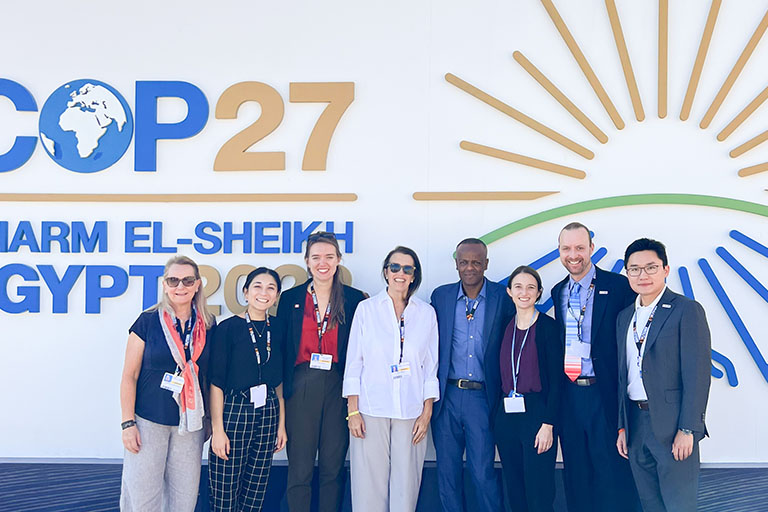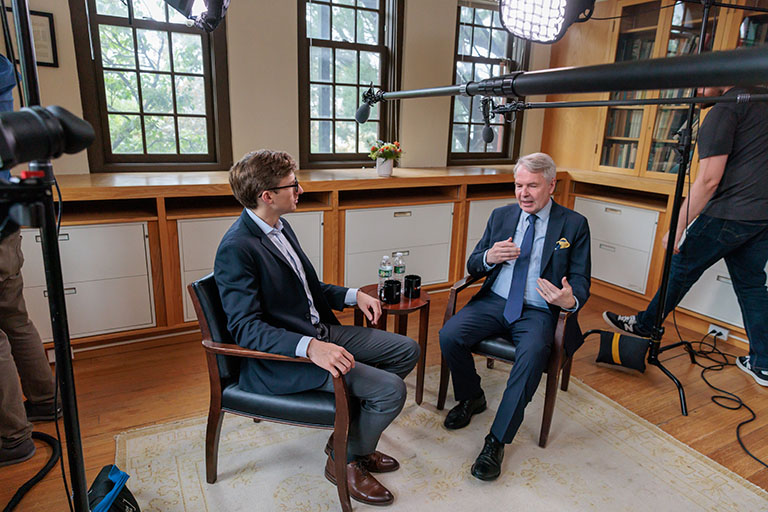-

Hear from Monica Toft, Academic Dean
Learn how Monica Toft, Academic Dean, is shaping the study of global affairs and diplomacy at Fletcher.
Hear from Prof. Toft -

Explore Fletcher academics in action
Fletcher Features offers insights, innovation, stories and expertise by scholars.
Get global insights -
Get application tips right from the source
Learn tips, tricks, and behind-the-scenes insights on applying to Fletcher from our admissions counselors.
Hear from Admissions -

Research that the world is talking about
Stay up to date on the latest research, innovation, and thought leadership from our newsroom.
Stay informed -
Meet Fletcherites and their stories
Get to know our vibrant community through news stories highlighting faculty, students, and alumni.
Meet Fletcherites -

Forge your future after Fletcher
Watch to see how Fletcher prepares global thinkers for success across industries.
See the impact -

Global insights and expertise, on demand.
Need a global affairs expert for a timely and insightful take? Fletcher faculty are available for media inquiries.
Get in Touch
Climate Policies Must Include, and Learn From, the LGBTQI+ Community
For CIERP’s Pride Month blog series, Fletcher student Miriam Israel (MALD ’24) offers her thoughts about how policymakers could address and prevent the impacts of climate change by learning from examples set by the LGBTQI+ community.

Despite significant achievements in recent years for the protection and provision of equal rights for LGBTQI+ people, there are still significant barriers to full inclusion in society. Around the world, LGBTQI+ issues are often co-opted by political parties and used to stoke anxieties about national or cultural identity, Western influence or other social, economic or political challenges. LGBTQI+ individuals also face barriers to housing, education, medical care and other critical services, while social stigma serves to isolate them from their family and community. In the United States alone, LGBTQI+ individuals, particularly youth and transgender people, are estimated to make up nearly 40% of those experiencing homelessness, making them even more vulnerable to things like substance abuse, depression or anxiety and assault.
In countries where LGBTQI+ identities are further stigmatized, or even criminalized outright, there are particular barriers to steady employment and many openly LGBTQI+ individuals are forced to work in the informal economy. Many people in the informal economy, like street vendors or sex workers, spend a significant amount of time outdoors, and as such are more vulnerable to extreme heat or cold, as well as natural disasters. The instability of the informal economy also results in unreliable income that makes it particularly difficult to recover from sudden shocks, whether they be natural disasters, economic downturns or public health crises
At the same time, an increasingly unpredictable climate and more extreme weather events present a serious threat to all people, with the most damaging impacts already being felt by those who are socially and economically marginalized. This disproportionate exposure to climate change serves to exacerbate existing inequality by trapping people in a vicious cycle where they are both more likely to experience harm and less equipped to recover from it. As a result, climate change policies, from investments in renewable energy to protections against sea level rise need to acknowledge this disparity and provide extra attention to high-risk populations. The most recent report from the Intergovernmental Panel on Climate Change (IPCC) Working Group II on Impacts, Adaptation and Vulnerability highlighted this point by drawing an explicit connection between the vulnerability of ecosystems and the vulnerability of people that is “driven by patterns of intersecting socio-economic development, unsustainable ocean and land use, inequity, marginalization, historical and ongoing patterns of inequity such as colonialism, and governance.”
As described in the IPCC report, it is clear that many of these patterns which contribute to climate change also uphold or exacerbate existing inequalities. This means that appropriately designed climate change solutions present an opportunity not only to protect our natural environment but also to address environmental justice issues while improving socio economic inclusion for marginalized groups like the LGBTQI+ community. By prioritizing inclusion and considering the unique needs of LGBTQI+ people, climate policies can address long standing inequalities and more effectively respond to climate change impacts.
One policy area where consideration of the LGBTQI+ community is especially critical is natural disaster and extreme weather response. As explained above, LGBTQI+ people are more likely to be exposed to these types of events. They are also likely to face barriers in accessing support services in the aftermath of a natural disaster or during extreme weather. Programs designed to assist people in these cases are likely to exclude LGBTQI+ individuals if they require information about someone’s gender identity to participate, or if they provide gender-segregated services, such as emergency housing or heating/cooling centers. Service providers often collect gender information from participants, however this can alienate people who are transgender or gender non-conforming, or others who feel that disclosing their gender identity might put them at risk.
This concept can also be applied to services that rely on a traditional understanding of family to assign benefits, like disaster recovery assistance or temporary relocation following a natural disaster. LGTBQI+ couples and families might be deemed ineligible for these types of services because they lack legal recognition of their marriage or relationship status. In some places, it might also be dangerous for same-sex couples to identify themselves, due to the risk of violence or discrimination. Carefully considering the purpose of this information, and only requiring it when absolutely necessary, will increase the likelihood that LGBTQI+ people are able to benefit from these services, and will likely make them more accessible for all people by reducing the administrative burden on providers and governments.
Another area where the needs of LGBTQI+ people should be considered is in urban sustainability and climate resilience. The IPCC Working Group II report highlighted how cities are hotspots for climate risk but also critical for building climate solutions. Ongoing rapid urbanization, combined with resource scarcity and other climate impacts, will strain city infrastructure and threaten the safety of marginalized people. As cities work to “go green” and build more environmentally friendly housing, transportation and public space, they need to ensure that LGBTQI+ safe spaces are maintained and that their communities are not uprooted as a result of these developments. Cities can also work to prioritize LGBTQI+ people and other marginalized groups in their plans for an economic transition away from fossil fuels and make sure that jobs training or opportunities in clean energy are open to all people, regardless of gender identity. By thinking holistically and working to build the climate resilience of all residents, cities and governments can improve their overall ability to cope with climate shocks while also fostering inclusion.
In this regard, policymakers working on climate issues have a lot they can learn from the LGBTQI+ community, and the history of movements for LGBTQI+ equality. Despite facing both explicit criminalization and implicit discrimination, LGBTQI+ people around the world continue to fight for everything from equal legal status, appropriate medical care and access to safe community spaces, while refusing to leave the most marginalized members of the community behind. Existing in the world as an LGTBQI+ person requires being realistic about the limitations of the world around you, while also being hopeful about the type of world that is possible in the future. It requires creativity to reimagine the systems that create inequality and harm people and the planet. Responses to climate change desperately need this type of hope and creativity, and by learning from the examples set by the LGBTQI+ community, policy makers will be better prepared to address and prevent the impacts of climate change in a way that benefits everyone.
Miriam Silverman Israel is a MALD candidate at The Fletcher School at Tufts University.

